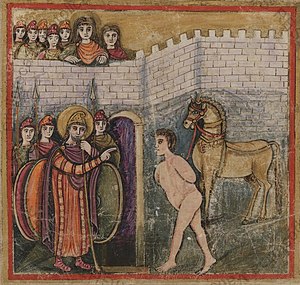
Back Buchmalerei ALS منمنمة Arabic Miniatura AST Miniatür sənəti Azerbaijani مینیاتور AZB Мініяцюра Byelorussian Миниатюра Bulgarian Minijatura BS Miniatura Catalan Iluminace Czech

A miniature (from the Latin verb miniare, "to colour with minium", a red lead[1]) is a small illustration used to decorate an ancient or medieval illuminated manuscript; the simple illustrations of the early codices having been miniated or delineated with that pigment. The generally small scale of such medieval pictures has led to etymological confusion with minuteness and to its application to small paintings, especially portrait miniatures,[2] which did however grow from the same tradition and at least initially used similar techniques.
Apart from the Western, Byzantine and Armenian[3] traditions, there is another group of Asian traditions, which is generally more illustrative in nature, and from origins in manuscript book decoration also developed into single-sheet small paintings to be kept in albums, which are also called miniatures, as the Western equivalents in watercolor and other media are not. These include Arabic miniatures, and their Persian, Mughal, Ottoman and other Indian offshoots.
- ^ Wedgwood, Hensleigh (1855). "On False Etymologies". Transactions of the Philological Society (6): 70.
- ^ One or more of the preceding sentences incorporates text from a publication now in the public domain: Williamson, George Charles (1911). "Miniature". In Chisholm, Hugh (ed.). Encyclopædia Britannica. Vol. 18 (11th ed.). Cambridge University Press. pp. 523–528.
- ^ Emma Korkhmazian, Gravard Akopian, Irina Drampian, The Armenian Miniature — Collection of the Matenadaran (Yerevan), Art Edition Aurora, Léningrad, 1984, p.7.
© MMXXIII Rich X Search. We shall prevail. All rights reserved. Rich X Search